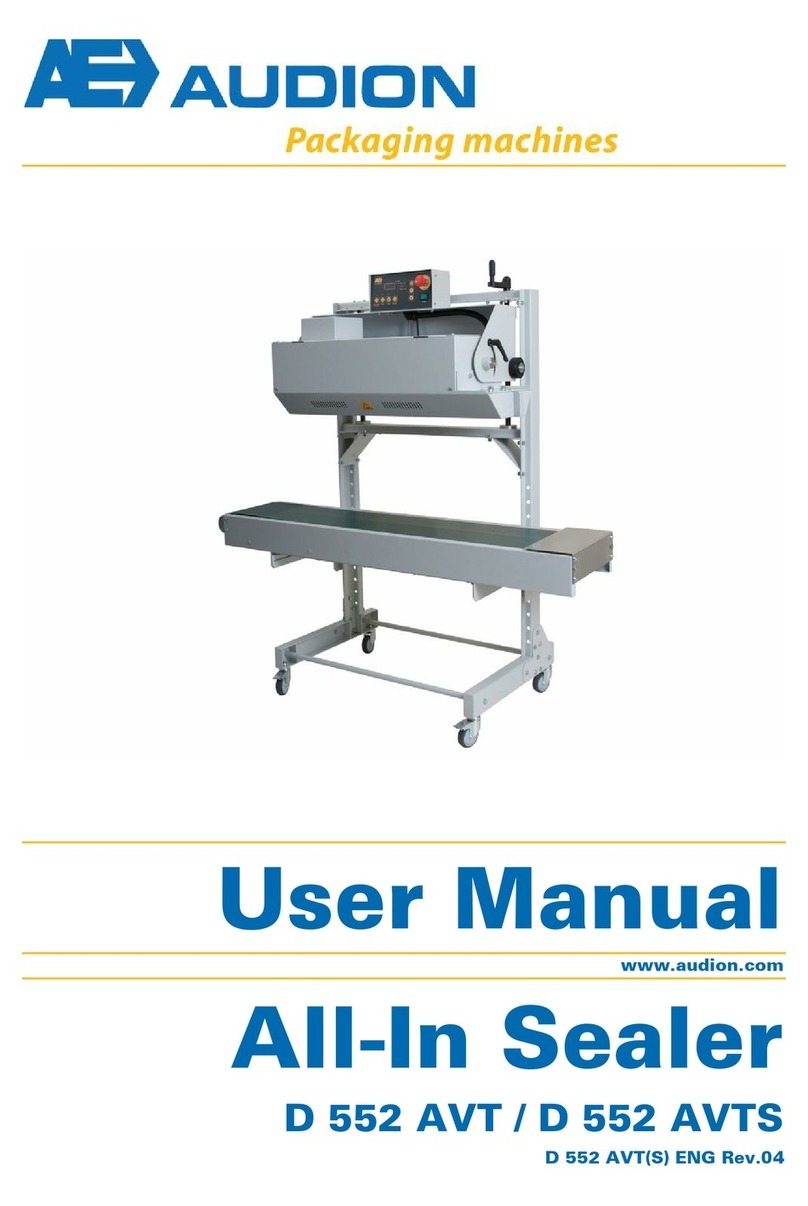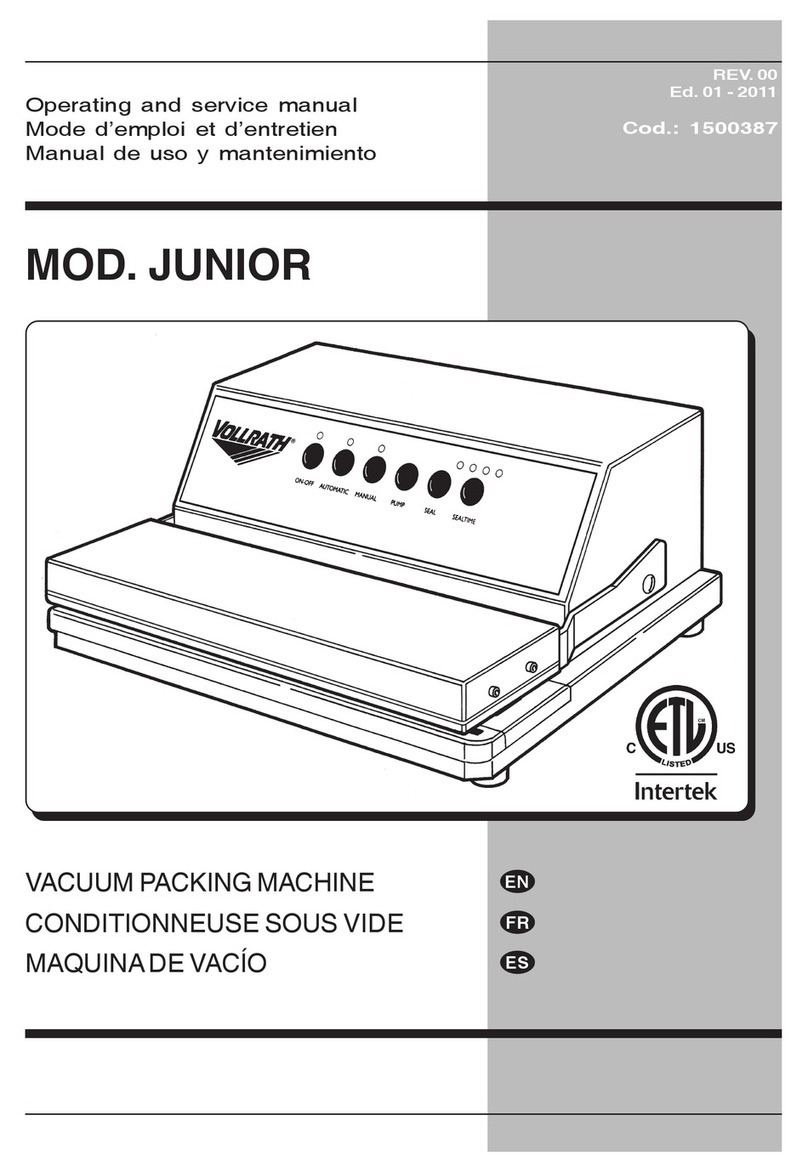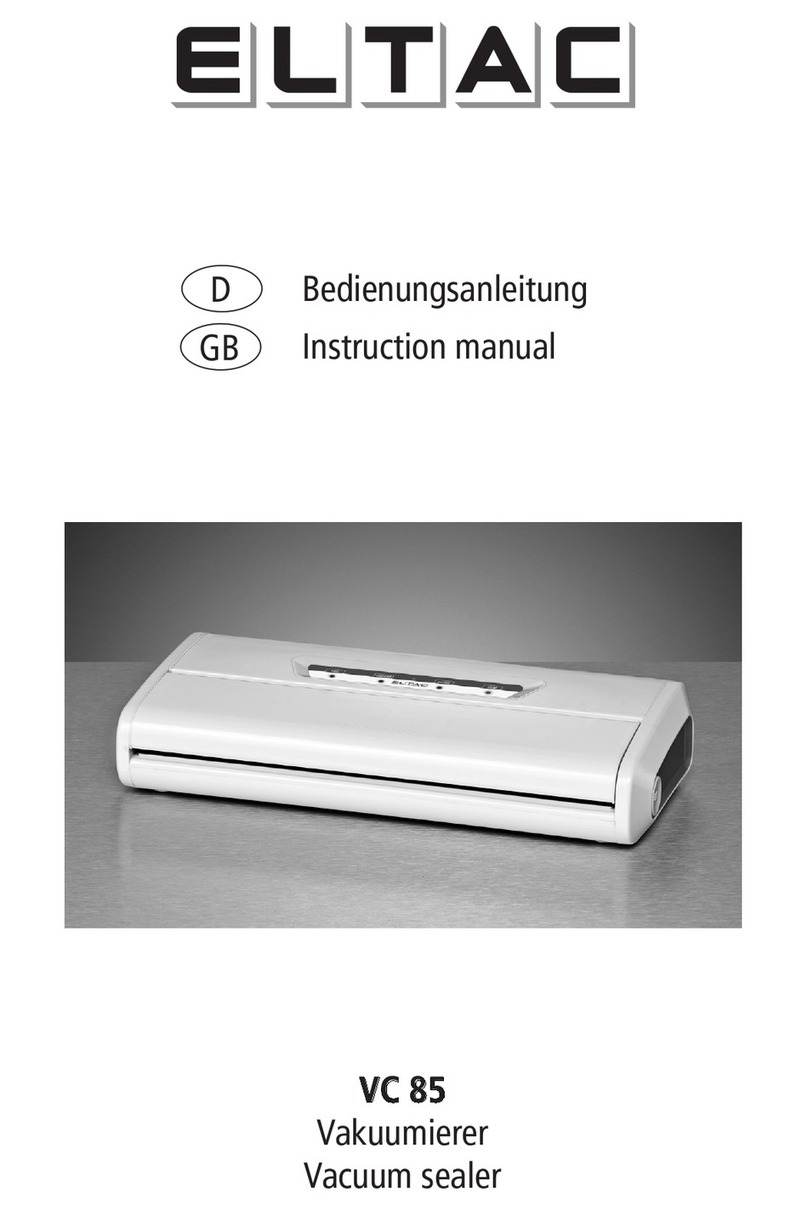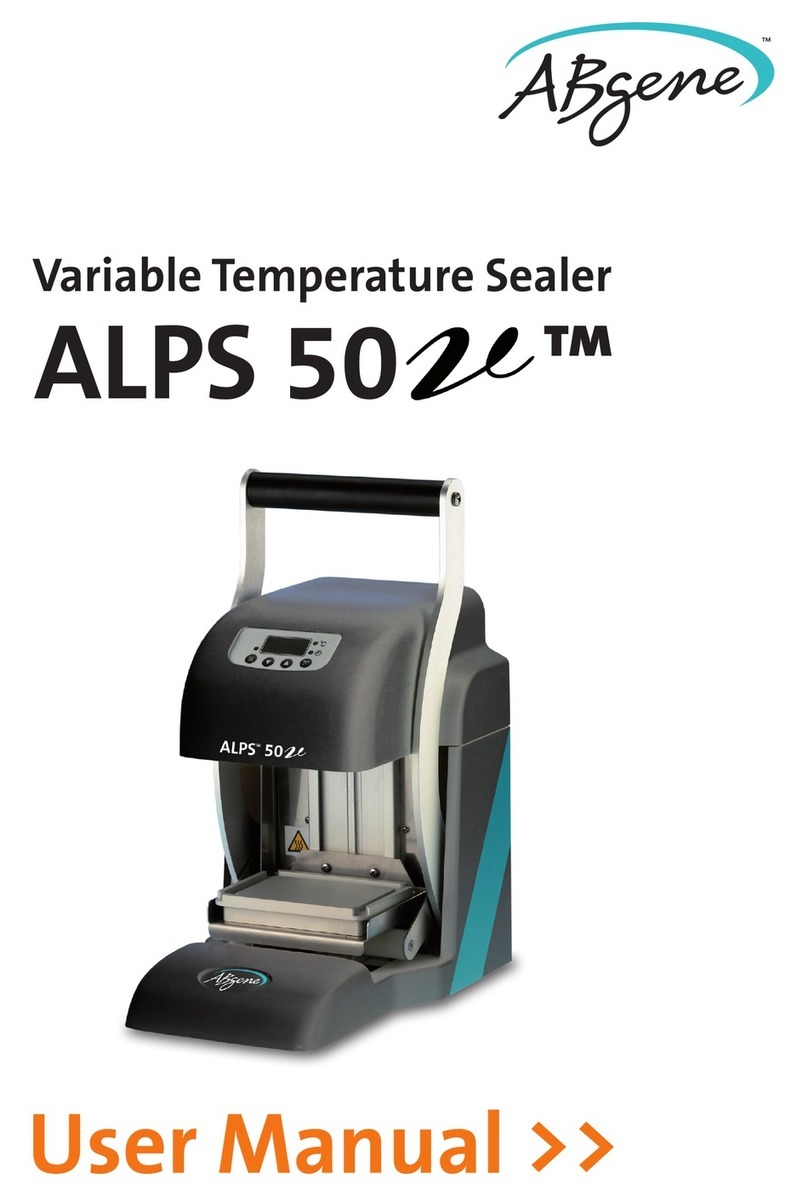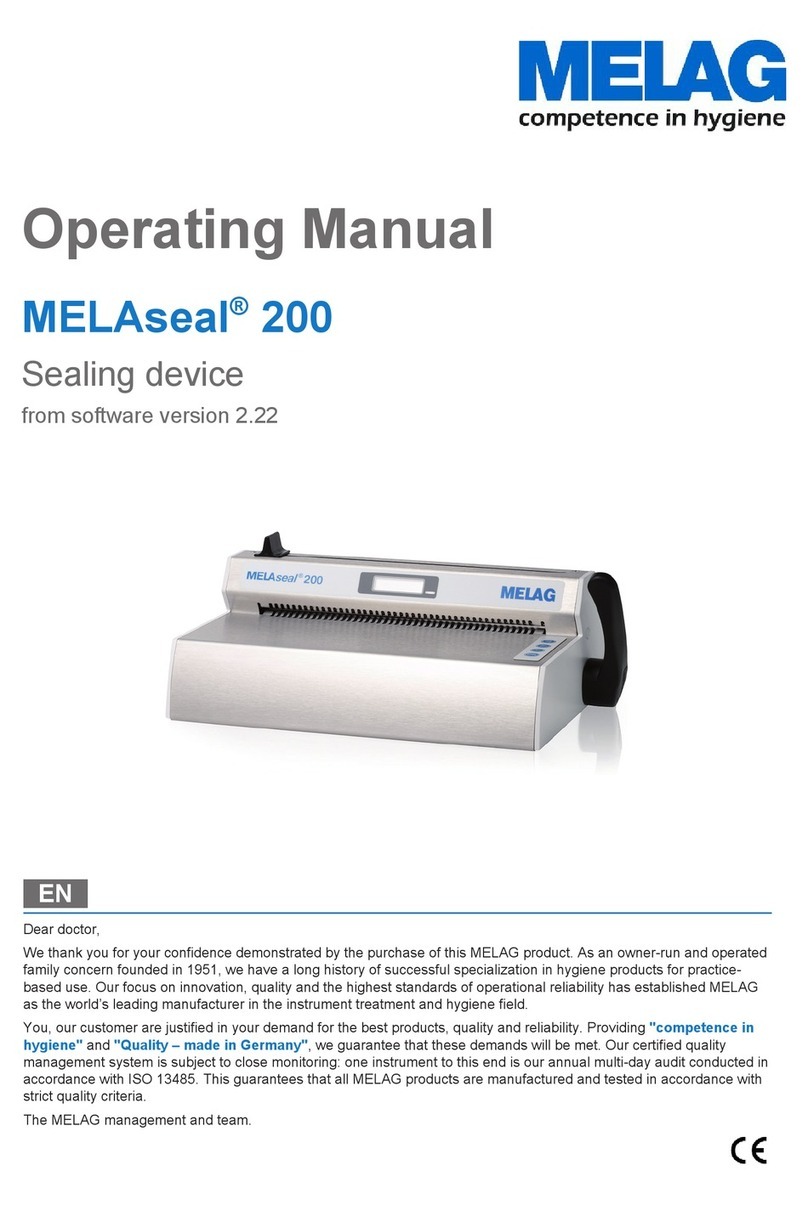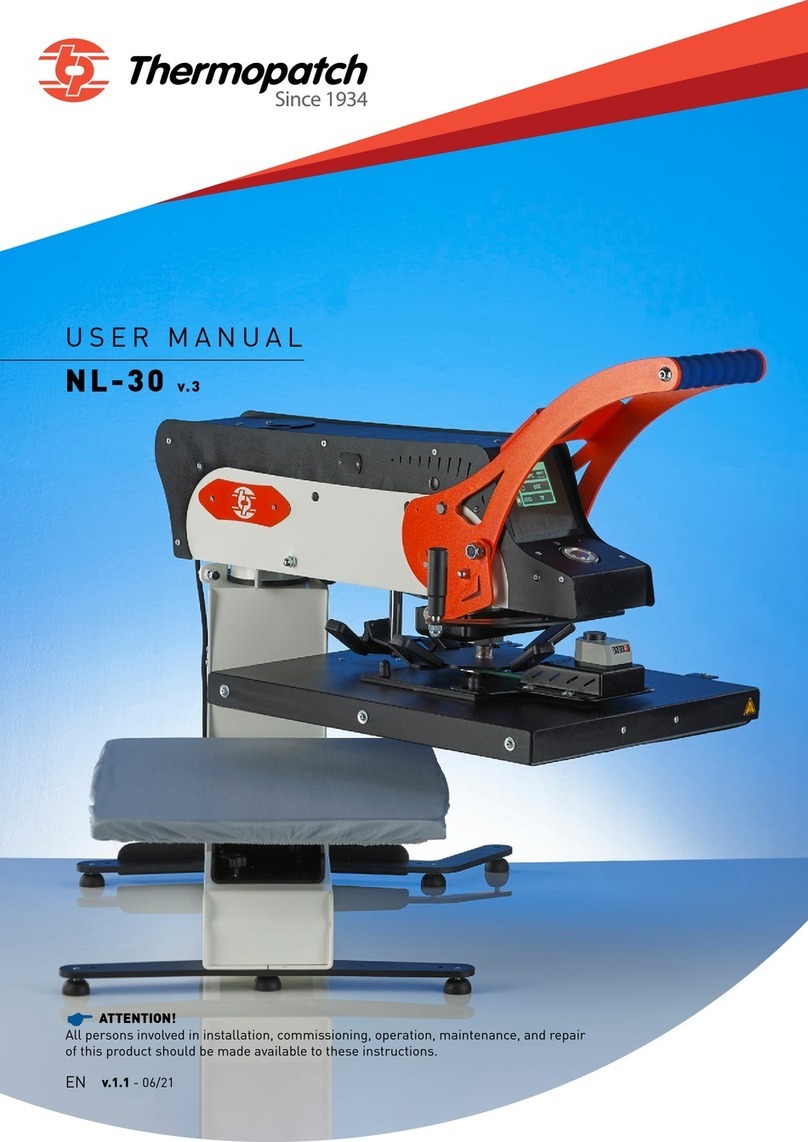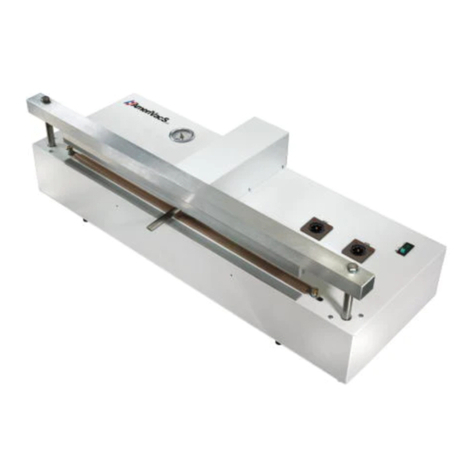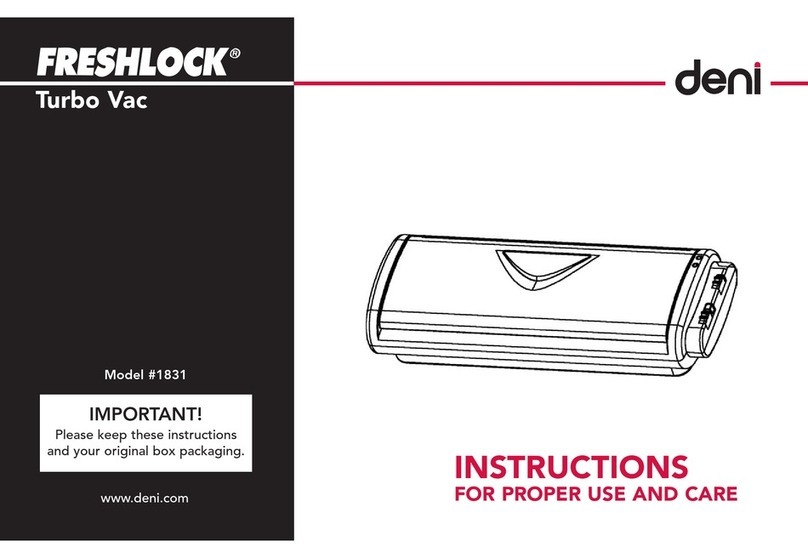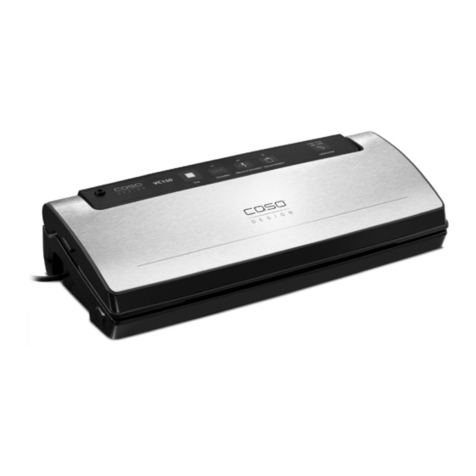Audion D541 User manual

Continuous sealer
D541
D541 ENG Rev.01
User manual
www.audion.com
-

'translation of the original instructions'
All rights reserved.
No part of this publication may be reproduced and/or published by means of print, photocopy,
or in any other way, without prior written permission from Audion Elektro BV.
Audion Elektro BV reserves the right to modify the machine and/or change the operating manual
without prior notice.
Audion Elektro BV is not liable for any damage caused by specifications deviating from the
standard version.
Although this operating manual was compiled with the utmost care, Audion Elektro BV does not
accept any liability for any mistakes it may contain and/or the consequences of any incorrect
interpretation of its contents.
Audion Elektro BV is not liable for any damage or problems resulting from the use of parts other
than original parts. If this operating manual does not provide instructions for certain repairs,
settings or maintenance, please contact your dealer or Audion Elektro BV.

Please read this operating
manual carefully before using
the sealer or carrying out
maintenance on it.
The sealer is part of the Audion
product range. We also
provide:
- Impulse sealers.
- Heat sealers.
- Continuous sealers.
- Vacuum sealers.
- Vacuum chambers.
- Crimping machines.
- Validatable sealers.
- Form, fill and seal machines.
Since its inception in 1947,
Audion has gained a lot of
experience and expertise with
a wide variety of sealing and
packaging machines. Our
solutions for packaging
problems are unique. Our many
years of experience together
with our modern production,
assembly and testing methods
ensure that our packaging
machines meet the highest
quality standards. We can also
customise the machines
according to your specific
requirements.
Audion is the right supplier for
a packaging machine that is
geared to your requirements.
Continuous sealer
D541

Contents
4
Contents
1 Introduction . . . . . . . . . . . . . . . . . . . . . . . . . . . . . . . . . . . . . . . . . . . . . . . . . . . . . . . 6
1.1 Manufacturer . . . . . . . . . . . . . . . . . . . . . . . . . . . . . . . . . . . . . . . . . . . . . . . . . . 6
1.2 Machine type plate . . . . . . . . . . . . . . . . . . . . . . . . . . . . . . . . . . . . . . . . . . . . . . 6
1.3 Warranty conditions and liability . . . . . . . . . . . . . . . . . . . . . . . . . . . . . . . . . . . . . 7
2Safety. . . . . . . . . . . . . . . . . . . . . . . . . . . . . . . . . . . . . . . . . . . . . . . . . . . . . . . . . . . . 8
2.1 Symbols used in this manual . . . . . . . . . . . . . . . . . . . . . . . . . . . . . . . . . . . . . . . 8
2.2 User . . . . . . . . . . . . . . . . . . . . . . . . . . . . . . . . . . . . . . . . . . . . . . . . . . . . . . . . 9
2.2.1 Operating personnel . . . . . . . . . . . . . . . . . . . . . . . . . . . . . . . . . . . . . . . . . . . 9
2.2.2 Maintenance personnel . . . . . . . . . . . . . . . . . . . . . . . . . . . . . . . . . . . . . . . . . 9
2.3 Safety instructions . . . . . . . . . . . . . . . . . . . . . . . . . . . . . . . . . . . . . . . . . . . . . 10
2.3.1 General safety instructions . . . . . . . . . . . . . . . . . . . . . . . . . . . . . . . . . . . . . 10
2.3.2 What to do in case of fire . . . . . . . . . . . . . . . . . . . . . . . . . . . . . . . . . . . . . . 11
2.3.3 Use for special applications . . . . . . . . . . . . . . . . . . . . . . . . . . . . . . . . . . . . . 12
2.4 Safety provisions . . . . . . . . . . . . . . . . . . . . . . . . . . . . . . . . . . . . . . . . . . . . . . 12
3 Installation . . . . . . . . . . . . . . . . . . . . . . . . . . . . . . . . . . . . . . . . . . . . . . . . . . . . . . . 13
3.1 Unpacking the sealer . . . . . . . . . . . . . . . . . . . . . . . . . . . . . . . . . . . . . . . . . . . . 13
3.2 Fixing the adhesive feet. . . . . . . . . . . . . . . . . . . . . . . . . . . . . . . . . . . . . . . . . . 13
3.3 Connecting the sealer . . . . . . . . . . . . . . . . . . . . . . . . . . . . . . . . . . . . . . . . . . . 14
4 Description
Continuous sealer15
4.1 Function . . . . . . . . . . . . . . . . . . . . . . . . . . . . . . . . . . . . . . . . . . . . . . . . . . . . 15
4.2 Overview of the Continuous sealer . . . . . . . . . . . . . . . . . . . . . . . . . . . . . . . . . . 16
4.3 Control panel . . . . . . . . . . . . . . . . . . . . . . . . . . . . . . . . . . . . . . . . . . . . . . . . . 17
4.3.1 Coolrun mode . . . . . . . . . . . . . . . . . . . . . . . . . . . . . . . . . . . . . . . . . . . . . . 17
5 Operation . . . . . . . . . . . . . . . . . . . . . . . . . . . . . . . . . . . . . . . . . . . . . . . . . . . . . . . . 18
5.1 Switching on the sealer . . . . . . . . . . . . . . . . . . . . . . . . . . . . . . . . . . . . . . . . . . 18
5.1.1 Setting the sealing temperature . . . . . . . . . . . . . . . . . . . . . . . . . . . . . . . . . . 18
5.1.2 Adjusting the film guide . . . . . . . . . . . . . . . . . . . . . . . . . . . . . . . . . . . . . . . 19
5.2 Sealing . . . . . . . . . . . . . . . . . . . . . . . . . . . . . . . . . . . . . . . . . . . . . . . . . . . . . 19
5.2.1 Sealing of large bags. . . . . . . . . . . . . . . . . . . . . . . . . . . . . . . . . . . . . . . . . . 19
5.2.2 Sealing of smaller bags . . . . . . . . . . . . . . . . . . . . . . . . . . . . . . . . . . . . . . . . 19
5.3 Stopping the sealer (STANDBY mode) . . . . . . . . . . . . . . . . . . . . . . . . . . . . . . . . . 20
5.4 Changing the operating settings . . . . . . . . . . . . . . . . . . . . . . . . . . . . . . . . . . . . 21
5.4.1 Resetting the default operating settings. . . . . . . . . . . . . . . . . . . . . . . . . . . . . 23
6 Troubleshooting . . . . . . . . . . . . . . . . . . . . . . . . . . . . . . . . . . . . . . . . . . . . . . . . . . 24

Continuous sealer
D541
Contents 5
7 Maintenance . . . . . . . . . . . . . . . . . . . . . . . . . . . . . . . . . . . . . . . . . . . . . . . . . . . . . 26
7.1 Maintenance schedule . . . . . . . . . . . . . . . . . . . . . . . . . . . . . . . . . . . . . . . . . . . 27
7.1.1 Weekly maintenance . . . . . . . . . . . . . . . . . . . . . . . . . . . . . . . . . . . . . . . . . . 27
7.1.2 Monthly maintenance . . . . . . . . . . . . . . . . . . . . . . . . . . . . . . . . . . . . . . . . . 27
7.1.3 Annual maintenance . . . . . . . . . . . . . . . . . . . . . . . . . . . . . . . . . . . . . . . . . . 27
7.2 Replacing the PTFE fibreglass belts . . . . . . . . . . . . . . . . . . . . . . . . . . . . . . . . . . 28
7.3 Replacing the fuse . . . . . . . . . . . . . . . . . . . . . . . . . . . . . . . . . . . . . . . . . . . . . 30
8 Disposing of the machine . . . . . . . . . . . . . . . . . . . . . . . . . . . . . . . . . . . . . . . . . 31
8.1 Directive 2002/96/EC . . . . . . . . . . . . . . . . . . . . . . . . . . . . . . . . . . . . . . . . . . . 31
8.2 Correct disposal for reuse . . . . . . . . . . . . . . . . . . . . . . . . . . . . . . . . . . . . . . . . 31
Bijlage 1 Technical information . . . . . . . . . . . . . . . . . . . . . . . . . . . . . . . . . . . . . . 32
B1.1 Dimensional drawing . . . . . . . . . . . . . . . . . . . . . . . . . . . . . . . . . . . . . . . . . . . . 32
B1.2 Technical information . . . . . . . . . . . . . . . . . . . . . . . . . . . . . . . . . . . . . . . . . . . 33
Bijlage 2 Electrical Diagram . . . . . . . . . . . . . . . . . . . . . . . . . . . . . . . . . . . . . . . . . . 35
Bijlage 3 Spare parts . . . . . . . . . . . . . . . . . . . . . . . . . . . . . . . . . . . . . . . . . . . . . . . . 37
B3.1 Wear parts. . . . . . . . . . . . . . . . . . . . . . . . . . . . . . . . . . . . . . . . . . . . . . . . . . . 37
B3.2 Service parts . . . . . . . . . . . . . . . . . . . . . . . . . . . . . . . . . . . . . . . . . . . . . . . . . 38
B3.3 Exploded view . . . . . . . . . . . . . . . . . . . . . . . . . . . . . . . . . . . . . . . . . . . . . . . . 39
Bijlage 4 Log. . . . . . . . . . . . . . . . . . . . . . . . . . . . . . . . . . . . . . . . . . . . . . . . . . . . . . . . 40
B4.1 Maintenance log . . . . . . . . . . . . . . . . . . . . . . . . . . . . . . . . . . . . . . . . . . . . . . . 41
Bijlage 5 EC declaration . . . . . . . . . . . . . . . . . . . . . . . . . . . . . . . . . . . . . . . . . . . . . 42

Introduction
6
1 Introduction
1.1 Manufacturer
The Continuous sealer was manufactured by:
1.2 Machine type plate
The sealer has an EC mark. This means that the sealer meets the fundamental
health and safety requirements of the European Communities.
Audion Elektro BV
Hogeweyselaan 235
1382 JL Weesp
The Netherlands
Telephone: +31 (0)294 491717
Fax: +31 (0)294 491755
Email: [email protected]
Web: www.audion.com
Figure 1-1: Machine type plate of the Continuous sealer

Continuous sealer
D541
Introduction 7
1.3 Warranty conditions and liability
Subject to the limitations stated below, we provide a 12-month warranty for the
products we deliver. This warranty is limited to manufacturing defects and
therefore does not cover any malfunctions caused by any form of wear, or any
part of the delivered product that is subject to wear.
•The warranty we provide for parts or accessories purchased from third parties
is limited to the warranty the third-party provides to us.
•The warranty is void if the other party and/or any third parties engaged by
them use the product in a way that it is not intended for.
•The warranty is also void if the other party and/or any third parties engaged
by them carries out work and/or modifications on the delivered product.
•Any parts we replace in order to meet our warranty obligations become our
property.
•Should the other party not meet obligations resulting from the agreement
entered into between the parties in whole or in part or in a timely manner, we
are not obliged to provide warranty for as long as that situation continues.
We exclude all liability to the extent that the liability is not regulated by law. Our
liability will never exceed the total amount of the order in question.
Subject to the generally applicable legal rules of public order and good faith, we
are not obliged to pay compensation to the other party or any third party for
damages of any nature whatsoever, incurred directly or indirectly, including
trading loss, damage to movable or immovable property or persons.
In any case, we are not liable for any damage resulting from or caused by using
the delivered product or its unsuitability for the purpose for which the other party
purchased it.

Safety
8
2 Safety
2.1 Symbols used in this manual
The following symbols are used in this user manual:
A tip on how a task can be carried out more efficiently.
Instructions for carrying out a task in the correct manner.
Danger of injury to the user or damage to the sealer if the
instructions are not observed.

Continuous sealer
D541
Safety 9
2.2 User
The sealer should only be operated by authorised personnel.
Improper use of the sealer may lead to serious personal injury and
considerable material damage.
Keep bystanders at a distance. Do NOT allow unauthorised
personnel to operate the sealer.
2.2.1 Operating personnel
The company using the machine has organized a training to inform its operating
personnel of the potential risks of unskilled behaviour while carrying out their
tasks.
Installation, maintenance and repair require specialised
knowledge, which is why these tasks should only be performed by
maintenance personnel.
Observe the safety instructions in this user manual. Failure to
observe the safety instructions may cause unacceptable risks.
The operating personnel must be familiar with all chapters of this user manual
with the exception of ’Installation’ and ’Maintenance’. Always observe the
following safety instructions before using the sealer or carrying out any
maintenance work.
2.2.2 Maintenance personnel
This personnel's professional training, knowledge and experience, and knowledge
of the manufacturer's terms enable them to carry out the assigned work and
immediately recognize any risks that may arise.
Observe the safety instructions in this user manual. Failure to
observe the safety instructions may cause unacceptable risks.
Maintenance personnel must be familiar with all chapters of this user manual.
Always observe the following safety instructions before using the sealer or
carrying out any maintenance work on it.

Safety
10
2.3 Safety instructions
The sealer meets the fundamental health and safety requirements of the European
Community. This means that the sealer can be operated and maintained safely if
all safety instructions are carefully observed. However, improper or careless use
can create dangerous situations.
Observe the safety instructions in this user manual. Always
remain alert to dangerous situations and avoid any improper or
careless use.
2.3.1 General safety instructions
Observe the following general safety instructions:
•Tie back long hair.
•Do not wear loose clothing or jewellery.
•Always wear the personal protective equipment (PPE) prescribed by the
company, such as safety shoes, gloves, and goggles.
Use the PPE required on the shop floor, such as safety shoes,
gloves and goggles and/or hearing protection, in particular when
carrying out maintenance work.
•Check the operation of the sealer every day.
•Keep your hands away from dangerous parts of the sealer.
•Always leave protective covers in place during production.
•Never bypass or deactivate any safety provisions.
•The sealer should never be operated or maintained by people who are under
the influence of alcohol, medication and/or drugs.
•Only use sealable material that is suitable for the sealer.
•The user is obliged to observe the commonly applicable hygienic measures.
•If you are not sure whether the sealer is working properly, switch it off
immediately and consult the maintenance personnel.
•Both the user and the sealer must be supervised while the sealer is in use.

Continuous sealer
D541
Safety 11
•Do not switch the sealer back on until the malfunction has been repaired.
•Should any liquid or foreign object enter the machine, switch off the sealer
and immediately remove the plug from the wallsocket and have the sealer
checked by maintenance personnel before using it again.
•Should an unusual event occur, such as the development of smoke, remove
the plug from the socket immediately and have the sealer checked by
maintenance personnel before using it again.
•Remove the plug from the socket before carrying out any maintenance work.
•Never open the sealer's housing while it is connected to the mains power.
•Do not use any water, abrasive cleaning agents, chemical solvents or other
liquids when cleaning the sealer.
2.3.2 What to do in case of fire
NEVER use water to extinguish a fire. This may result in life-
threatening situations because the sealer may be live.
Should the sealer catch fire, never use water to extinguish the fire. Because the
sealer is live, this may result in life-threatening situations. A fire extinguisher must
be within reach when the sealer is in use. The following types of fire extinguishers
are suitable to extinguish a burning sealer:
•Powder extinguisher.
•Foam extinguisher.

Safety
12
2.3.3 Use for special applications
If the machine is used in a special environment, the company
using the machine must ensure that any instructions specific to
that environment are observed.
•If the machine is used in a medically sterile environment or clean room, the
company using the machine must ensure that any instructions specific to this
environment are observed.
•If the machine is used for the packaging of medical instruments, the company
using the machine must ensure that any instructions specific to this
environment are observed.
•If the machine is used for the packaging of food, the company using the
machine must ensure that any instructions specific to this environment are
observed.
2.4 Safety provisions
The sealer has the following safety provisions:
1. Safety covers.
-Electrical and mechanical parts in the housing are protected.
2. Metal parts are earthed.
-No dangerous voltage can develop between (external) metal parts and the
earth.
3. Fuse in 230 V circuit.
-If the voltage gets too high, the fuse will blow, cutting off the power sup-
ply.

Continuous sealer
D541
Installation 13
3 Installation
3.1 Unpacking the sealer
Check the following when unpacking the sealer:
1. Are all parts and accessories present?
-D541 sealer.
-Power cord.
-Set of adhesive feet.
-Instructions.
The sealer is packaged in environmentally friendly material that
can be disposed of as ordinary household waste.
Keep the box and the packaging material so the sealer can be
safely transported, should such be necessary.
3.2 Fixing the adhesive feet
1. Stick the adhesive feet to the bottom of
the sealer
The adhesive feet are important for
a good air flow to be realised
through the grate.
If the adhesive feet are not used,
the surface on which the sealer is
placed may be damaged.

Installation
14
3.3 Connecting the sealer
1. Connect the female plug of the power
cord to the sealer.
2. Put the plug in the socket.

Continuous sealer
D541
Description Continuous sealer 15
4 Description
Continuous sealer
4.1 Function
The D541 is a Continuous sealer for the packaging of a wide variety of products
in small series. The products are packaged in ready-to-use bags and subsequently
sealed. The sealer is suitable for ready-to-use bags made of polyethylene (PE),
polypropylene (PP), and aluminium laminates, with a thickness of between
2x20µm and 2x120µm.
Do not use the Continuous sealer for any other applications.
The sealer is not suitable for the following applications:
•Use in an explosive environment.
•Use in a clean room environment.
•Use in a medical environment.
•Packaging of pharmaceutical and therapeutic products.
•Packaging of toxic, corrosive or irritating substances.
•Packaging of explosive materials.
•Packaging of toxic, asphyxiant or irritating gases.
•Packaging of (hazardous) dusty products.
•Packaging of liquids.

Description Continuous sealer
16
4.2 Overview of the Continuous sealer
1. Housing
2. Handle
3. Control panel
4. Infeed guide
The sealer consists of a housing that contains electrical components. The handle
is located on the top of the housing. It is used to hold the sealer while large bags
are being sealed. The sealer may also be placed on its side, for example on a table.
In that case, the sealer is not held in the hand; ideal for sealing small bags.
Figure 4-1: Overview of the Continuous sealer
1
3
2
4

Continuous sealer
D541
Description Continuous sealer 17
4.3 Control panel
4.3.1 Coolrun mode
The coolrun mode prevents burning of the PTFE fibreglass belts. After the
machine has been stopped, the heater is switched off; however, the blower and
the motor will continue to run. When the sealing temperature has dropped to
below 80°C, the sealer is switched to stand-by mode and the blower and the
motor will also be switched off.
Figure 4-2: Control panel
1. Start/stop Press and hold for at least 1 second to start or stop
the sealer.
When the sealer is switched on, the display shows the
actual sealing temperature.
When the actual sealing temperature upon switching
off is over 80°C, the sealer will first switch to Coolrun
mode.
2. Up/down Press to increase or reduce the temperature setting.
3. Display Shows the actual sealing temperature. While making
changes, the set value is displayed (and the value in
the display is followed by a point).
1 32

Operation
18
5 Operation
If necessary, put the plug in the socket.
The seal bar gets hot during use. Touching it can result in serious
burns.
5.1 Switching on the sealer
Switch on the sealer as follows:
5.1.1 Setting the sealing temperature
The sealing temperature is set as follows:
1. Press the START/STOP button for 1 sec.
If necessary, put the plug in the
socket.
During the start-up, the operating
settings are visible in the display.
To change these settings, please
refer to section 5.4.
1. Press the ARROW keys to increase or
reduce the sealing temperature.
The guideline value for the sealing
temperature is 100°C.
When the actual sealing
temperature is within +/- 5°C of
the set value, the temperature
indicator will stop blinking.

Continuous sealer
D541
Operation 19
5.1.2 Adjusting the film guide
The film guide is adjusted as follows:
5.2 Sealing
5.2.1 Sealing of large bags
A product is sealed as follows:
5.2.2 Sealing of smaller bags
A product is sealed as follows:
1. Loosen the lock screw a few turns.
2. Adjust the film guide to the desired posi-
tion.
The seal should be made at least 5
mm from the top of the bag.
3. Tighten the lock screw again.
1. Take the sealer in your hand.
2. Guide the bag to be sealed into the
infeed guide.
3. Move the sealer across the bag to be
sealed.
1. Place the sealer on a stable surface.
2. Guide the bag to be sealed into the
infeed guide.

Operation
20
5.3 Stopping the sealer (STANDBY mode)
After use, stop the sealer as follows to put it in STANDBY mode:
1. Press the START/STOP button for 1 sec.
The sealer will now switch to
STANDBY mode; the display will
show a point in the bottom right-
hand corner of the display.
When the sealing temperature is
over 80°C, the sealer will first
switch to COOLRUN mode. The
heating is switched off and the
blower and the motor will continue
to run until the sealing temperature
has dropped to below 80°C. The
display will alternate between show
"c-r" and the "actual temperature".
After that, the sealer is
automatically switched to STANDBY
mode.
When the START/STOP button is
pressed for longer than 3
seconds, the sealer will
immediately switch to STANDBY
mode, even if the sealing
temperature is higher than 80°C.
Use this way of switching off
only if absolutely necessary. It
may cause the PTFE fibreglass
belts to burn sooner.
If the sealer is not going to be used
for a longer period of time, it is
better to switch it off completely
by removing the plug from the
socket.
Table of contents
Other Audion Food Saver manuals
